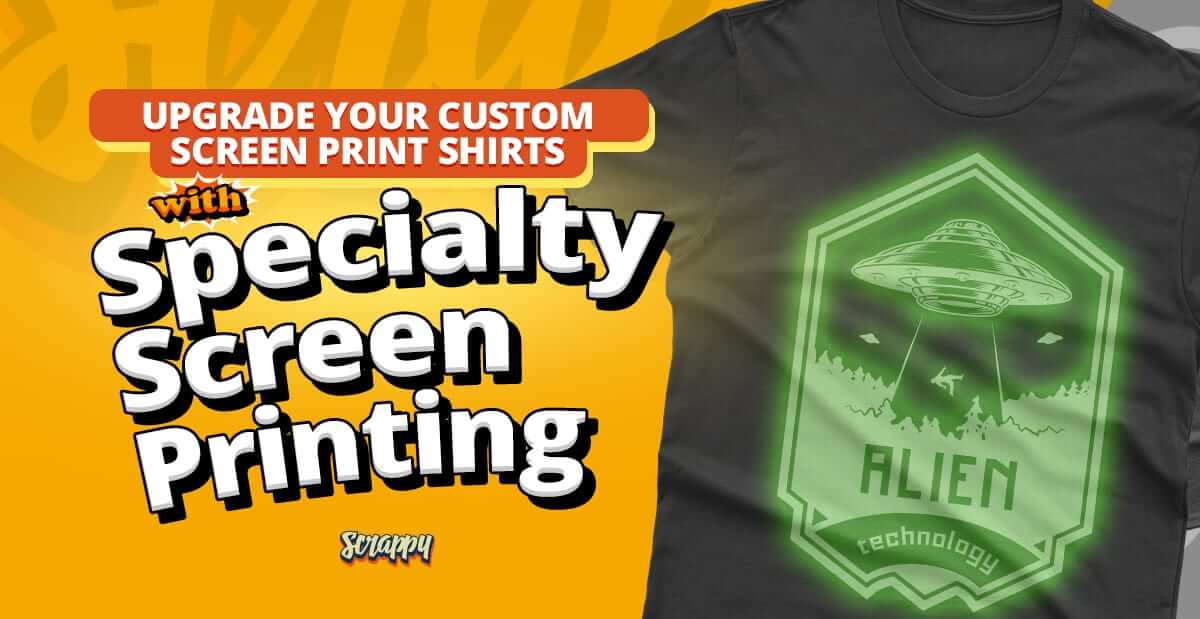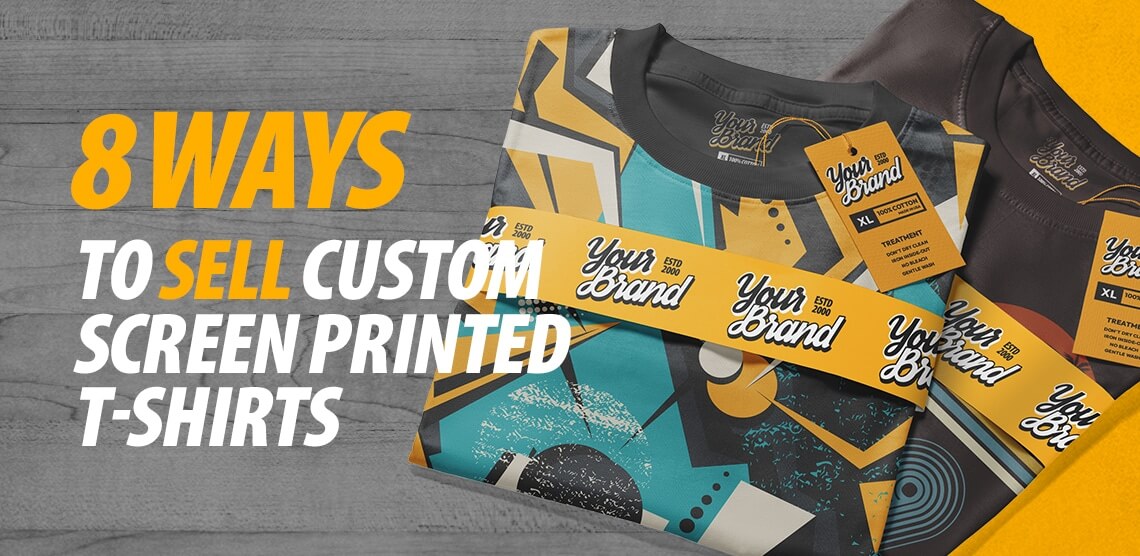Durable T-Shirt Printing for Everyday Wear
Wiki Article
Display Printing Uncovered: Everything You Required to Know About Tee Shirt and Garment Printing Strategies
If you have actually ever before asked yourself just how those vibrant designs finish up on your favored tee shirts, you remain in the appropriate area. Screen printing is an interesting technique that incorporates art with method, providing limitless opportunities for imagination. Comprehending the basics, from devices to ink options, can considerably affect your results. Ready to check out the essential aspects that make display printing an art kind? Let's discover the details that can boost your jobs.
The Basics of Screen Printing: How It Works
When you dive into display printing, you'll discover it's both a scientific research and an art. At its core, screen printing involves creating a pattern, or screen, that allows ink to pass via just in details areas (screen printing kit). You begin by selecting your design and preparing your display with a light-sensitive solution. When you expose this solution to light, it hardens, leaving your layout as a negative space.Setting the screen over the textile, after that use a squeegee to push ink via the screen onto the garment. Each action is essential, and mastering them will elevate your screen printing skills, transforming basic garments right into unique, expressive items.
Kinds Of Screen Printing Strategies
Once you grasp the basics of screen printing, it's time to explore the various techniques that can boost your layouts. One popular technique is conventional display printing, where ink is pushed with a stenciled screen.If you're going for fine details, take into consideration discharge printing. This method gets rid of dye from the material, leaving a soft, vintage look. An additional alternative is plastisol printing, recognized for its longevity and brilliant colors, making it a favorite for many brand names. Experiment with halftone printing to develop gradient effects and complex styles. Each strategy has its special appeal, so don't hesitate to attempt them out to find what fits your style best!
Vital Tools for Display Printing
To achieve sensational cause display printing, having the appropriate equipment is essential. Initially, you'll need a strong display printing frame, which holds the mesh that moves your layout onto the garment. Next off, purchase top quality mops; these are essential for using ink uniformly throughout the screen. You'll also call for a good direct exposure device to create your screens, in addition to a washout cubicle for cleaning them after usage. A dependable warmth source, like a conveyor clothes dryer or warm press, is important for treating your prints to assure longevity. Do not forget an appropriate work space, furnished with tables and storage for your supplies. Finally, safety equipment, such as masks and gloves, will certainly keep you risk-free from chemicals and inks. With the right tools, you'll be well on your method to creating professional-quality prints.Picking the Right Inks and Materials
When picking inks and materials for screen printing, you need to think about the kind of ink that works ideal for your job. Believe about material compatibility to ensure your designs look terrific and last long. Check out environmentally friendly ink options to make your printing procedure a lot more sustainable.Kinds Of Display Inks
Choosing the ideal screen ink is vital for achieving lively, resilient prints that meet your project's needs. There are several kinds of display inks to check out. Specialized inks, such as metallic or glow-in-the-dark, can add one-of-a-kind effects to your styles.
Textile Compatibility Considerations
Comprehending fabric compatibility is vital for attaining top notch display prints, specifically since various products react uniquely to various inks. When picking inks, take into consideration the textile kind-- cotton, polyester, or blends. For cotton, water-based inks work well, providing softness and breathability. Polyester, on the other hand, often calls for plastisol inks for far better attachment and vibrant colors. If you're printing on blends, you might require to utilize a combination of both kinds. Always test your inks on sample fabric to ensure they adhere correctly and keep shade honesty. Additionally, remember that material weight and structure can influence the final end result, so picking the best ink and material combination is important for your job's success.Eco-Friendly Ink Options
Eco-friendly inks are becoming a preferred option for display printers who want to minimize their ecological influence while maintaining top quality. When picking inks, think about water-based inks, which are less hazardous and easier to clean up compared to conventional solvents.Additionally, look for inks made from renewable energies, such as soy or vegetable-based options. By picking the right inks and products, you'll not just develop spectacular layouts but likewise contribute to a much more lasting printing process. Make the switch, and your prints will certainly mirror your commitment to the setting!
Preparing Your Design for Screen Printing

Submit Format Needs
To ensure your design looks sharp and vibrant on material, you'll need to pay very close attention to file layout requirements for display printing. Start with vector files like AI or EPS, as they can be scaled without shedding top quality. If you make use of raster images, go with high-resolution data, such as TIFF or PNG, ideally at 300 DPI. Avoid utilizing JPEGs, as they can shed clarity when resized. Likewise, make certain your layout has a transparent background to stop unwanted white edges on your prints. Keep shade settings in mind; CMYK is basic for display printing, so convert your RGB designs accordingly - screen printing kit. By complying with these guidelines, you'll establish your art work up for an effective print.Color Splitting Up Strategies
Color splitting up is an important step in preparing your design for screen printing, and mastering it can significantly improve your print top quality. You'll require to break your style into private shades, as each color needs a separate screen throughout printing. This precision not just assures precise shade representation yet likewise simplifies the printing procedure.Resolution and Size
Accomplishing the most effective results in display printing starts with assuring your style has the appropriate resolution and size. Preferably, your art work should go to the very least 300 DPI (dots per inch) for sharp, clear prints. Your last product could look unprofessional and pixelated. if you make use of lower resolution.When it involves dimension, consider the measurements of your print area. Design your artwork to match the final print size, preferably producing it in the real dimensions you'll be printing. This method, you'll prevent any unexpected scaling issues.
Always examine your design in both vector and raster layouts. Vector graphics can be scaled without shedding high quality, making them optimal for screen printing. Preparing properly will ensure your style looks remarkable on every garment!
Step-by-Step Display Printing Process
Display printing is a dynamic process that allows you to develop vivid layouts on different surfaces. To get started, you'll need a screen, emulsion, and your selected ink.Pour ink onto the display and use a squeegee to push the ink via the pattern onto the material. Raise the display meticulously and allow the print completely dry. You have actually successfully screen published your design.
Tips for Effective Screen Printing Projects
While you're diving right into your display printing jobs, bear in mind that prep work is essential to success. Start by collecting all your materials-- inks, mops, garments, and screens. A tidy workspace aids avoid undesirable errors, so clean before you start.Next, confirm your artwork is high-resolution and properly sized for your garment. Examine your display for proper direct exposure and tidy it thoroughly to avoid smudges. When mixing your inks, follow the producer's standards to attain the right consistency.
Throughout printing, use even pressure with your squeegee for consistent results. Don't hurry; take your time to confirm each print satisfies your requirements. After printing, let your garments dry entirely prior to taking care of or packaging them.
Finally, always maintain an example of your job for future recommendation. This method, you can assess your progression and improve your methods with time. Happy printing!

Frequently Asked Questions
Exactly how Lengthy Does It Require To Establish up a Screen Printing Job?
Establishing up a display printing task usually takes about 30 minutes to an hour. You'll prepare the displays, mix inks, and readjust the press. The time varies based on complexity and experience, so remain organized!Can I Publish on Various Textile Keys In Utilizing the Very Same Technique?
Yes, you can print on various fabric types making use of the exact same strategy, however you'll need to readjust your inks and settings. Some fabrics absorb ink differently, so trying out guarantees the most effective outcomes for every product.What Prevail Blunders to Avoid in Screen Printing?
When display printing, avoid typical mistakes like utilizing the incorrect ink, overlooking correct exposure times, or skipping pre-press checks. Always evaluate your setup and preserve tidy screens to ensure high quality results each time.Exactly How Can I Correctly Tidy and Preserve My Display Printing Devices?
To correctly clean and maintain your screen printing equipment, you ought to consistently wash displays with ideal solvents, examine squeegees for wear, and ensure all devices are saved dry and dust-free. Uniformity avoids costly repair services and improves performance.Is Screen Printing Eco-friendly Compared to Various Other Approaches?
Display printing can be much more eco-friendly than various other techniques, particularly if you utilize eco-conscious materials and water-based inks. By choosing lasting materials and methods, you reduce waste and minimize your effect on the planet.Screen Printing Uncovered: Whatever You Need to Know Concerning Tee Shirt and Garment Printing Strategies
At its core, screen printing includes developing a pattern, or display, that allows ink to pass with only in particular areas. Setting the screen over the material, after that make use of a squeegee to press ink through the display t-shirt printing onto the garment. One prominent method is conventional display printing, where ink is pushed with a stenciled screen.When selecting inks and products for display printing, you need to take right into account the type of ink that functions best for your job.
Report this wiki page